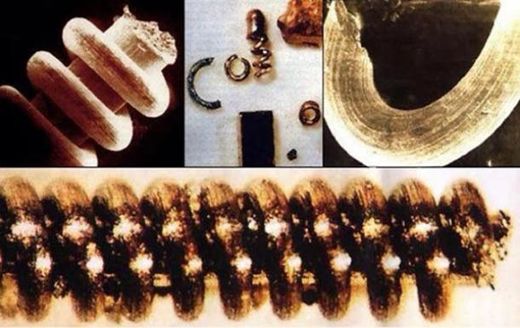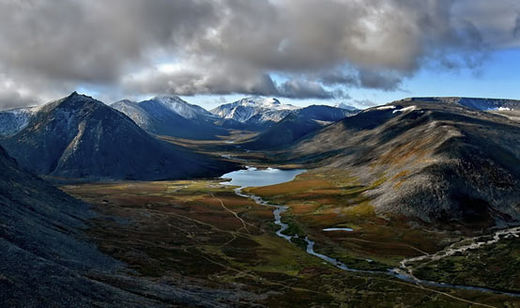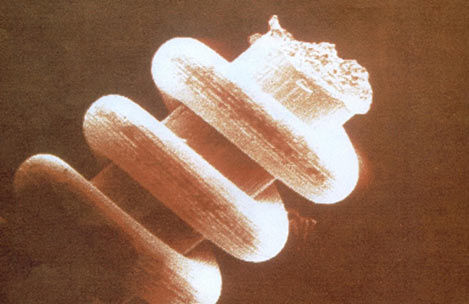
As I was told by Dr. Valerii Ouvarov (St. Petersburg), further analyses of the mysterious spiralswere carried out by the out-stations of the Russian Academy of Sciences in St. Petersburg and in Syktyvar (former capital of the Komi ASSR), and also at an independent institute in Helsinki.
I have before me the Expertise No. 18/485 of 29th November 1996, by the aforementioned Institute (ZNIGRI) [3], the original Russian text of which I reproduced in my book WENN GOETTER GOTT SPIELEN. Due to the short time before the book went to press, a correct and complete translation was not possible. This was only possible after a sworn translator had been brought in [4].
The author of the Expertise is Scientific Assistant Mme. Dr. E. W. Matveyeva, of the Section for Geology, Prospecting Techniques, and Economics of Precious Metal Alluvial Deposits. She reports first on the development of the discovery site, then the testing procedures used for the analysis of the thread-shaped tungsten spirals in the alluvial deposits of the Balbanyu river. The exact location of the site is given by ZNIGRI as follows: it is a development in the alluvial deposits of the third flood-terrace on the (looking downstream) left bank of the river Balbanyu, oriented along borehole line no. 106. Loose sediments are found in this development, which are represented as follows, working upwards from the oldest to the youngest deposits:
1 A structured weathering-crust (alternating chalk and carbon-containing slate with grey-blue and brown-yellow banding: visible thickness 0.5 - 1.0 metres.)
2. Included lenticles (Einschlusslinsen) of 0 to 0.2 metres of weakly-sorted sand, gravel, clay, and fine detrital material, which can be designated as erosion products of stratum 1. described above.
3. Deposits of grey gravel and detrital material of various grain sizes with well washed-out sands and a visible thickness of 1 to 1.7 metres, which could be investigated for possible gold content.
4 Gravel-containing sand and clay deposits, grey-coloured, with a visible thickness of 2.0 metres. In the upper region of this sediment can be seen evidence of disturbance by grading work.
As regards the age of the strata which contain the tungsten and molybdenum artefacts, Dr Matveyeva states as follows: The layer which contains the spiral-shaped objects is characterised as gravel and detritus deposits of No. 3 stratum, which in our view, show inner-sedimentary erosion of polygenetic accumulative layers (i.e. layers composed of material of various origins). From their orientation these layers can be dated to 100,000 years and correspond to the lying parts (i.e. the lower regions) of the Mikulinsk horizon of the upper Pleistocene.[3]
In the geological time-scale, the Pleistocene is that part of the Quaternary, the latest geological epoch, which began about 2 million years ago and ended around 10,000 years ago. After that followed the Holocene, in which we are at the moment.
The report continues by describing the tests carried out, which include the use of an electrom microscope type JSM T-330 made by the Japanese firm Jeol. This also yielded data of various spectroscopic analyses [5].
[Figure 2 - Micro-artefact found in the Urals Click on picture for larger image.]
Particular attention should be paid to the final conclusion reached by the Moscow institute. Report No. 18/485 states that the age of the deposits and the results of the tests give a very low probability to the assumption that the origin of these unusual, thread-shaped tungsten crystals is of a technogenic cosmic nature, due to the rocket take-off route from the Plesetsk space-station over the polar part of the Ural region.
In plain language: these objects cannot have originated from earlier test rockets or similar fired from Plesetsk. The key word of the report comes finally to the point: The data obtained allow the possibility of an extra-terrestrial technogenic origin.[3]
In view of these conclusions, critics will find it very difficult to accuse me of pseudo-documentationor embarrassing behaviour. On the contrary: I will try to obtain further investigation reports from the independent Finnish research institute, on which greater value might be placed.
My hypothesis is that these artefacts are so-called nano-technology, which I can sustain with reference to a recent publication [6]. Researchers all over the world are working on miniature pistons, gear wheels, switches, and other control elements, to be used in nano-robots. These workers will soon be in a position to achieve results which hitherto have been the province of science fiction.
Surely the last word has not yet been said about the sensational finds in the Ural mountains!
*
Literature and remarks
1. Hausdorf H. Wenn Goetter Gott spielen Muenchen 1997
2. Hausdorf H. Sensationeller Fund in Russland Ancient Skies, 2/1997
3. Matveyeva, E.W. Conclusions on the finds of threrad-shaped tungsten spirals in the alluvial deposits of the Balbanyu river. ZNIGRI Analysis 18/485 of 29 Nov. 1996
4. In this connection I must thank the Aldea Translation Bureau in Cologne for good co-operation and much help in the translation from the Russian.
5. I would be glad to send interested readers a copy of the complete ZNIGRI report for the cost and postage, also representative micro-photographs.
6. Nanotechnologie Faktor X, 5/1997
Posted by Amzer Zo (here)
Posted by buares (here)
Posted by Bill Ryan (here)








 Reply With Quote
Reply With Quote













Bookmarks